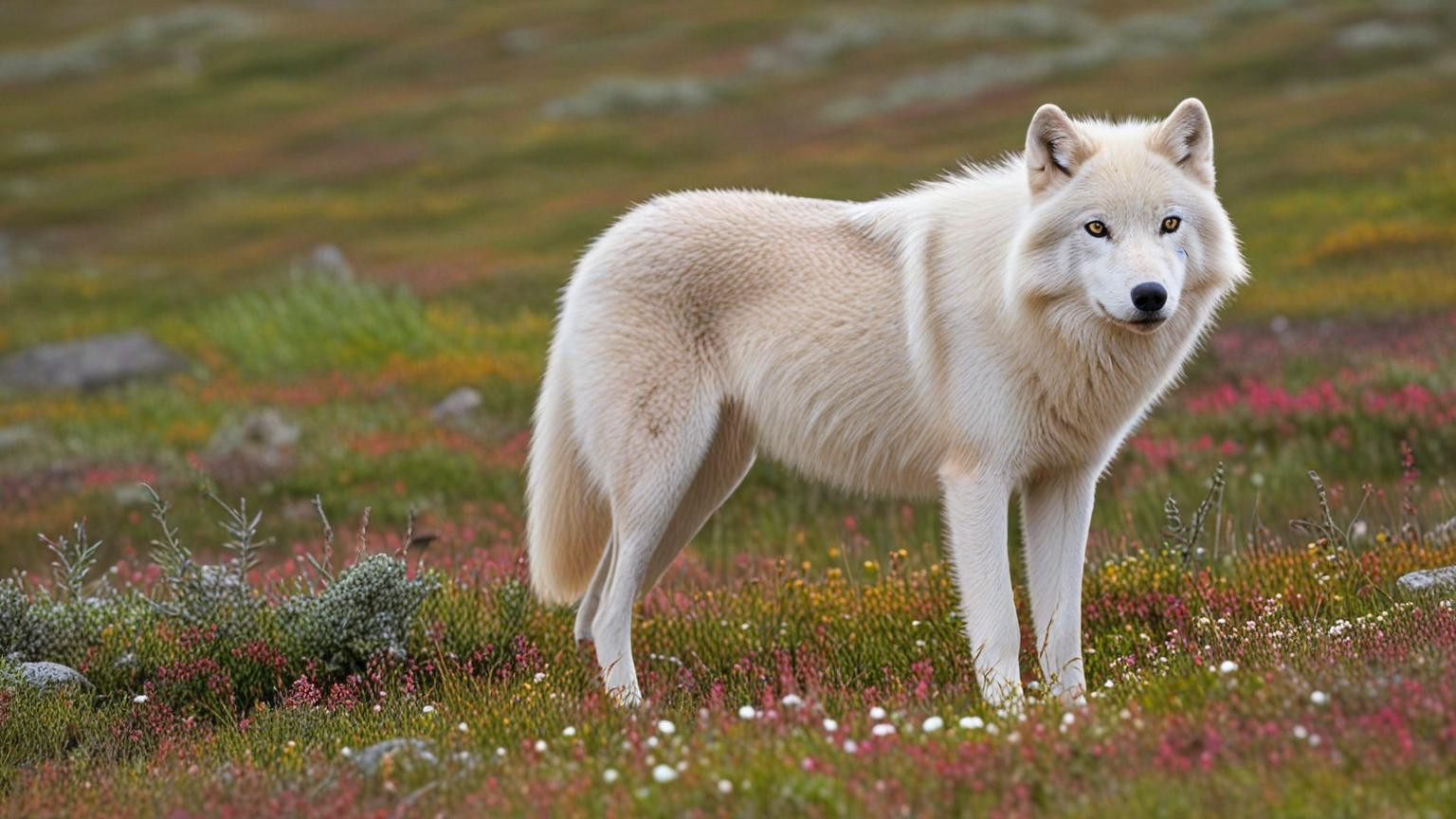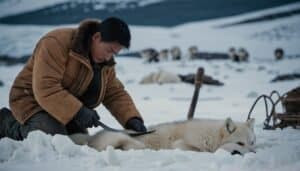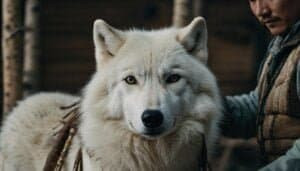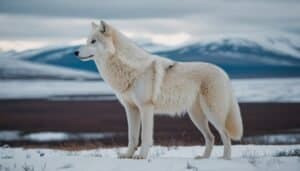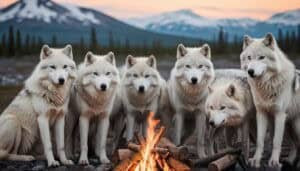Introduction
In traditional Arctic medicine, the use of Arctic wolf parts has been a practice rooted in the rich cultural heritage of Arctic communities
This article explores the various parts of the Arctic wolf used for medicinal purposes, their healing properties, and the historical and cultural context of these practices. We will also delve into modern perspectives, including scientific studies and ethical considerations surrounding the use of Arctic wolves in traditional medicine
Specific Arctic Wolf Parts Used In Traditional Medicine
In traditional Arctic medicine, various parts of the Arctic wolf are believed to hold significant medicinal properties. These practices are deeply ingrained in the cultural heritage of Arctic communities and have been passed down through generations
Here, we will examine the specific parts of the Arctic wolf that are utilized in these traditional practices
Arctic Wolf Bones
Arctic wolf bones are among the most commonly used parts in traditional Arctic medicine. The bones are often ground into a fine powder and used for various medicinal purposes
One of the primary uses of Arctic wolf bone powder is in the treatment of bone-related ailments. It is believed to help strengthen bones and alleviate conditions such as arthritis and osteoporosis. The calcium and other minerals in the bones are thought to contribute to their healing properties
In some Arctic cultures, wolf bones are also used in the creation of amulets and charms, which are believed to provide protection and promote healing. These amulets are often worn by individuals suffering from chronic illnesses or those who require physical strength and resilience
Arctic Wolf Fur
Arctic wolf fur is another valuable component in traditional Arctic medicine. The fur is often used to create warm garments and blankets, which are essential for survival in the harsh Arctic climate. Beyond its practical uses, Arctic wolf fur is believed to possess therapeutic properties
The warmth provided by wolf fur garments is thought to alleviate symptoms of respiratory illnesses, such as colds and bronchitis, by keeping the body warm and aiding in the recovery process
Additionally, some Arctic communities use wolf fur in traditional healing rituals. The fur is sometimes burned, and the smoke is believed to have purifying and healing effects. This practice is often conducted during ceremonies aimed at cleansing individuals of negative energies and promoting overall well-being
Arctic Wolf Organs
The organs of the Arctic wolf are used in various traditional remedies
For example, the liver and heart are considered to be highly nutritious and are often consumed to boost strength and vitality. The consumption of wolf liver is believed to improve eyesight and overall health due to its high vitamin A content. Similarly, the heart is thought to enhance physical endurance and courage
In some traditions, wolf organs are also used to prepare medicinal broths and soups. These broths are consumed to treat a range of ailments, from digestive issues to general fatigue. The nutritional benefits of these organs are considered vital in maintaining the health and well-being of individuals in Arctic communities, especially during the long, harsh winters
Healing Properties And Benefits
The healing properties and benefits of Arctic wolf parts have been valued in traditional Arctic medicine for centuries. These practices are not just about the physical aspects of healing but also incorporate spiritual and cultural elements
This section delves into the various illnesses treated using Arctic wolf parts, the methods of preparation, and the rituals and practices involved in their use
Treatment Of Illnesses
Arctic wolf parts are utilized to treat a range of illnesses, both physical and spiritual:
Respiratory Conditions: As mentioned earlier, Arctic wolf fur is used to create garments and blankets that help alleviate respiratory conditions. The warmth provided by these items is believed to soothe symptoms of colds, bronchitis, and other respiratory ailments
Bone and Joint Issues: The powdered bones of the Arctic wolf are used to treat bone and joint problems, including arthritis and osteoporosis. The minerals in the bone powder are thought to strengthen bones and reduce inflammation, providing relief from pain and stiffness
Nutritional Deficiencies: Consuming Arctic wolf organs, such as the liver and heart, is believed to address nutritional deficiencies. The high vitamin A content in the liver can improve eyesight, while the heart is considered beneficial for boosting stamina and physical strength
Digestive Disorders: Medicinal broths made from wolf organs are used to treat digestive disorders. These broths are rich in nutrients and are thought to aid digestion, relieve stomach discomfort, and increase overall vitality
Preparation Methods
The preparation methods for Arctic wolf parts in traditional medicine are diverse and often intricate, reflecting the deep knowledge and skills of Arctic healers:
Bone Powder: To create bone powder, Arctic wolf bones are thoroughly cleaned and then dried. Once dried, the bones are ground into a fine powder using traditional tools. This powder can be mixed with water, teas, or other herbal concoctions for consumption
Fur Garments: The fur is carefully treated and processed to make garments and blankets. This involves cleaning the fur, tanning it to preserve its properties, and then sewing it into the desired items. These garments are worn or used as bedding to provide warmth and therapeutic benefits
Organ Consumption: Organs like the liver and heart are typically consumed raw or cooked. In some practices, the organs are eaten directly after a hunt, believed to transfer the strength and spirit of the wolf to the person consuming them. Alternatively, they may be cooked into soups or stews, enhancing their nutritional value and making them easier to consume
Medicinal Broths: To prepare medicinal broths, Arctic wolf organs are boiled with various herbs and other natural ingredients. This process extracts the nutrients and medicinal properties into the broth, which is then consumed to treat various ailments
Rituals And Practices
The use of Arctic wolf parts in traditional medicine is often accompanied by rituals and practices that are deeply rooted in the cultural and spiritual beliefs of Arctic communities:
Healing Ceremonies: Healing ceremonies involving Arctic wolf parts may include chants, prayers, and dances. These ceremonies are performed by shamans or healers to invoke the spiritual powers of the wolf and enhance the healing process. The ceremonies are designed to cleanse the individual of negative energies and promote overall well-being
Purification Rituals: Burning Arctic wolf fur is a common purification ritual. The smoke produced during this process is believed to have cleansing properties that can drive away evil spirits and negative influences. This ritual is often performed in homes or community spaces to ensure a healthy and harmonious environment
Protective Amulets: As mentioned earlier, wolf bones are sometimes fashioned into amulets and charms. These items are blessed during special ceremonies and worn to provide protection, health, and strength to the wearer. The belief in the protective power of these amulets is a testament to the spiritual significance of the Arctic wolf in these cultures
Historical And Cultural Context
Understanding the historical and cultural context of using Arctic wolf parts in traditional medicine provides insight into the deep-rooted traditions and beliefs of Arctic communities. These practices have evolved over centuries and are integral to the identity and survival of these communities
Origins Of Medicinal Use
The medicinal use of Arctic wolf parts dates back to ancient times when early Arctic peoples relied heavily on their surrounding environment for survival
Wolves were not only a vital part of the ecosystem but also held significant spiritual importance. The belief that the wolf’s strength, agility, and keen senses could be transferred to humans through medicinal use was widespread
Historical records and oral traditions indicate that Arctic shamans or healers discovered the benefits of using wolf parts through a combination of observation and spiritual guidance. Wolves, known for their resilience and hunting prowess, were seen as embodiments of powerful natural forces. Shamans, who often acted as intermediaries between the physical and spiritual worlds, used wolf parts in rituals and healing practices to harness these powers
Cultural Significance
In many Arctic cultures, the Arctic wolf is revered as a symbol of strength, endurance, and survival. This reverence is reflected in the medicinal use of wolf parts, which is deeply intertwined with cultural and spiritual practices
For instance, the Inuit people, one of the primary Arctic groups, have long considered the wolf a spiritual guide and protector. The use of wolf parts in medicine is not merely a physical act but a spiritual one, aiming to align the patient with the powerful attributes of the wolf
The cultural significance of the Arctic wolf extends to various aspects of daily life. Stories, myths, and legends featuring wolves are common in Arctic folklore, often teaching lessons about bravery, cooperation, and respect for nature. These stories reinforce the importance of the wolf in the cultural consciousness and underscore the belief in its healing powers
Evolution Over Time
The use of Arctic wolf parts in traditional medicine has evolved over time, adapting to changes in the environment, social structures, and interactions with other cultures. Early practices were primarily based on immediate needs for survival and were deeply spiritual
However, with increased contact with other cultures and the advent of modern medicine, some traditional practices have diminished or transformed
Despite these changes, many Arctic communities continue to uphold their traditional medicinal practices, valuing them as an essential part of their heritage. Efforts to document and preserve these practices have gained momentum, recognizing their cultural significance and potential contributions to broader medical knowledge.
In recent years, there has been a growing interest in integrating traditional knowledge with modern scientific approaches. Researchers and medical professionals are increasingly acknowledging the value of traditional practices and exploring ways to validate and incorporate them into contemporary medicine
This integration not only respects and preserves cultural heritage but also enriches the overall understanding of medicinal practices
Modern Perspectives And Ethical Considerations
In contemporary times, the use of Arctic wolf parts in traditional medicine faces both renewed interest and significant ethical scrutiny
This section explores modern scientific perspectives on these traditional practices, the ethical issues they raise, and the conservation efforts aimed at protecting Arctic wolves
Scientific Studies
Recent scientific interest in traditional Arctic medicine has led to investigations into the medicinal properties of Arctic wolf parts. Researchers are examining the biochemical composition of wolf bones, organs, and fur to identify potential therapeutic compounds
For instance, studies have found that the high calcium content in wolf bones can indeed aid in bone health, supporting traditional claims about their use in treating arthritis and osteoporosis
Moreover, the nutritional benefits of consuming wolf organs, particularly the liver and heart, are being validated through scientific research. These organs are rich in essential vitamins and minerals, which can help address nutritional deficiencies. However, modern medicine emphasizes the importance of sourcing these nutrients from more sustainable and ethical alternatives
Despite these findings, scientific studies also highlight the need for caution. The consumption of raw animal organs poses risks of infections and parasites, which traditional practices might not fully address. Therefore, integrating traditional knowledge with modern health standards is crucial to ensure safety and efficacy
Ethical Issues
The ethical considerations surrounding the use of Arctic wolf parts in traditional medicine are complex. Key issues include the conservation status of Arctic wolves, the impact on biodiversity, and the welfare of the animals:
Conservation Status: Arctic wolves are not currently classified as endangered, but their populations are vulnerable to changes in their habitat due to climate change and human activities. The hunting of wolves for traditional medicinal purposes can contribute to population declines, raising concerns about sustainability
Biodiversity Impact: Arctic wolves play a crucial role in maintaining the balance of their ecosystem. Reducing their numbers can have cascading effects on other species and the overall health of the environment. This ecological impact needs to be carefully considered when evaluating the use of wolf parts in medicine
Animal Welfare: Ethical considerations also extend to the treatment and welfare of Arctic wolves. The traditional hunting methods may not align with modern standards of animal welfare, leading to debates about the morality of these practices. Ensuring humane treatment of animals and exploring alternative sources of medicinal compounds are important ethical imperatives
Conservation Efforts
In response to these ethical concerns, various conservation efforts are underway to protect Arctic wolves and their habitat. These efforts include:
Protected Areas: Establishing protected areas where Arctic wolves can thrive without the threat of hunting or habitat destruction. These conservation zones help preserve the natural behavior and populations of wolves
Sustainable Practices: Promoting sustainable hunting practices that balance the cultural significance of using wolf parts in traditional medicine with the need to conserve the species. This includes setting hunting quotas and using methods that minimize harm to the wolf population
Education and Advocacy: Raising awareness about the importance of Arctic wolves in the ecosystem and the ethical implications of their use in traditional medicine. Educating both local communities and the broader public helps foster a more balanced and respectful approach to these practices
Research and Collaboration: Encouraging collaboration between traditional healers, scientists, and conservationists to find alternative solutions that respect cultural traditions while protecting the species. This includes exploring plant-based or synthetic substitutes for medicinal compounds traditionally derived from wolves
Conclusion
In traditional Arctic medicine, the use of Arctic wolf parts has been a vital practice, deeply rooted in the cultural and spiritual lives of Arctic communities
The bones, fur, and organs of the Arctic wolf have been used for their purported healing properties, treating a range of illnesses and providing nutritional benefits. These practices are not just about physical healing but also encompass spiritual and cultural dimensions, reflecting a profound connection between Arctic peoples and their natural environment
However, modern perspectives bring both validation and scrutiny to these traditional practices. Scientific studies are beginning to confirm some of the traditional uses of Arctic wolf parts, while also highlighting potential risks and advocating for the integration of modern health standards. Ethical considerations, particularly regarding the conservation status of Arctic wolves, the impact on biodiversity, and animal welfare, add complexity to the discussion
Conservation efforts, sustainable practices, and collaborative research are essential to ensuring that the use of Arctic wolf parts in traditional medicine can continue in a way that respects both cultural heritage and modern ethical standards. Balancing these elements is key to preserving the rich traditions of Arctic communities while protecting the fragile Arctic ecosystem
By understanding the historical, cultural, and modern contexts of using Arctic wolf parts in traditional medicine, we can appreciate the depth of these practices and the importance of finding harmonious ways to sustain them in today’s world
